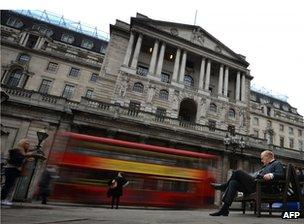How big is the 'material' hole in banks?
- Published
- comments

The Bank of England has said that banks need to raise more capital.
As I said it would yesterday, the Bank of England's Financial Policy Committee (FPC) has declared that big British banks need to raise more capital as protection against possible future losses.
But it has not cleared up the question of quite how much extra capital will be needed, how it should be raised and precisely when.
There are three reasons identified by the FPC for why the banks are not strong enough:
1)They are under-estimating the potential losses on loans to financially challenged borrowers, households and businesses, especially loans in forbearance (loans where the banks have temporarily eased cash payments - again see yesterday's column for more on this);
2)Banks may be hurt by further big fines or compensation payments relating to their past sins (the mis-selling of PPI or alleged LIBOR rigging, as just two examples);
3)Big banks' discretion to set their own risk weights for different categories of loans under the Basel rules may mean they have systematically understated the riskiness of entire categories of lending.
How much extra capital do the banks need?
Well that will be determined by a supposedly swift probe by the Financial Services Authority - but the Governor Sir Mervyn King said the hole needing to be filled would be "material".
For what it's worth, which is probably not a lot, the Bank of England and Financial Services Authority estimate that Barclays, HSBC, Lloyds and Royal Bank of Scotland would collectively be deficient of capital to the tune of between £5bn and £35bn, if they were all forced to use the same minimum risk weights on their loans.
However, the precision of this calculation is somewhat to be questioned because it is based on 2011 data and also because it excludes the banks' huge financial trading activities.
Or to put it another way, that range of £5bn to £35bn - broad as it is - might overstate or understate the true picture.
More definitively, the Bank of England says that the banks will not be able to fill the capital hole through retaining earnings, or via the profits they generate.
The options
So there are only three options: they can raise capital from investors; they can dispose of assets, where they have assets worth more than book value; or they can boost the ratio of capital to assets by refusing to roll over loans as loans fall due for repayment and by refusing to provide incremental credit.
Here, of course, are the economic and political risks of the bald statement that the banks are capital poor.
In the case of raising capital, the Treasury is making it crystal clear that it does not want taxpayers to put a bean of new money into Royal Bank of Scotland or Lloyds, the banks where the state has holdings of 80% and 40% respectively.
These banks may be able to raise some money by selling loss-absorbing debt to other investors. However that would probably not be sufficient.
So what about selling assets?
Well both banks are already engaged in huge asset sales forced on them by the European competition authorities.
For RBS in particular, there is a stark probable consequence of the Bank of England's capital prescription: it may well have to sell its relatively successful US retail operation, Citizens Bank; and it could be forced to pull out of investment banking more-or-less completely.
So what about the big question of moment to all of us: will the banks lend more or less as a result of today's announcement?
The governor of the Bank of England believes that once the banks are adequately capitalised, they will at last start providing sufficient credit to deserving households and businesses. Banking theory suggests he is right.
The problem is that until banks have all the capital they need, and as I have already mentioned, all the banks will be sorely tempted to boost the ratio of their capital to assets by lending less, to shrink the denominator in the calculation.
Or to put it another way, telling banks they have to raise material amounts of capital - without telling them how much capital and setting a deadline from them to find it - may have the perverse and damaging consequence of contracting the amount of credit supplied to the economy, and knocking economic recovery yet again.
That said, the Bank of England has tried to take pre-emptive action against this so-called deleveraging - by saying that new lending to households and businesses, under the Funding for Lending Scheme, will not attract any capital charge. So, in theory, if banks go on a lending strike, they will be cutting off their respective noses to spite their own faces.
Even so, it is moot whether banks really will feel like taking on the real credit risks of lending more to small businesses, for example, when they are being lectured by Sir Mervyn that they have been understating the risks on their historic lending.
And what does all this mean for the prospects for privatising Lloyds and RBS?
As a precursor to privatisation, both banks felt they had to start paying dividends again. And if they have to conserve and increase capital, the chances of dividends resuming in the coming two or three years has diminished very considerably.
Both banks had hoped that privatisation would begin in 2014 or 2015. But Sir Mervyn and his colleagues on the FPC may today have engineered yet another significant delay to the moment when taxpayers can celebrate severing the ties that bind us to Lloyds and RBS.